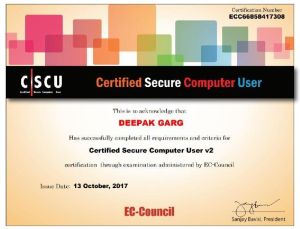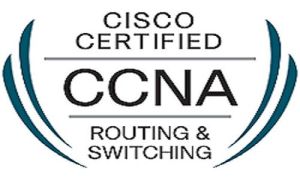
Secure Computer User (CSCU)

networking training
Content of ccna :- ==================== *basic networking *types of network * network devices * topologies :- 1>. Bus topology 2>. Ring topology 3>. Star topology 4>. Mesh topology 5>. Hybrid topology * osi layer (open systems interconnection model) * tcp/ip (transmission control protocol / internet protocol) * tcp / udp * cables :- 1>. Twisted pair cable 2>. Coxial cable 3>. Fiber-optic cable??? ip address (ipv4) * subnetting / vlsm * basic router information * password breaking of router * telnet??? ssh (secure shell) * dhcp (dynamic host configuration protocol) * cdp / lldp (cisco discovery protocol / link layer discovery protocol ) * mode of data transmission :- 1>. On the based of direction of exchanges. 2>. Serial and parallel transmission. 3>. Asynchronous & synchronous transmission. * what is routing & types of routing * static routing * default routing * dynamic routing * routing protocols :- 1>. Rip (routing information protocol):- i. Rip (version 1) ii. Rip (version 2) 2>. Eigrp (enhanced interior gateway routing protocol) 3>. Ospf (open shortest path first) 4>. Bgp (border gateway protocol ) * acl (access-control-list) * ntp (network time protocol) * nat (network address translation) :- 1>. Static nat 2>. Dynamic nat 3>. Pat (port address translation) * switch :- 1>. Vlan (virtual local area network) 2>. Vtp (vlan tranking protocol) 3>. Stp (spanning tree protocol) 4>. Ivr (inter vlan routing) 5>. Pssword breaking of switch * wan protocols :- 1>. Ppp (point to point protocol) 2>. Hdlc (high-level data link control) * frame relay * ip address version 6 (ipv6) * vpn (virtual private network)
...more
Certified Ethical Hacking Training
Description a certified ethical hacker is a skilled professional who understands and knows how to look for weaknesses and vulnerabilities in target systems and uses the same knowledge and tools as a malicious hacker, but in a lawful and legitimate manner to assess the security posture of a target system(s). The ceh credential certifies individuals in the specific network security discipline of ethical hacking from a vendor-neutral perspective. Course content : ==================================== 1> introduction 2> footprinting and reconnaissance 3> scanning networks 4> enumeration 5> system hacking 6> malware threats 7> sniffing 8> social engineering 9> denial of services 10> session hijacking 11> hacking web application 12> sql injection 13> hacking wireless network 14> hacking mobile platform 15> evading ids, firewalls, and honeypots 16> cloud computing 17> cryptography this course is designed to understand cybersecurity, as well as securing it by various latest methodologies. In this course, a student will learn penetration testing to secure the organization network by performing various techniques that are done by the intruders in order to gain access to the network for stealing data. Benefits of ethical hacking : ================================== most of the benefits of ethical hacking are obvious, but many are overlooked. The benefits range from simply preventing malicious hacking to preventing national security breaches. The benefits include: fighting against terrorism and national security breaches having a computer system that prevents malicious hackers from gaining access having adequate preventative measures in place to prevent security breaches ethical hacking tools : ================================== metasploit nmap wireshark nikto sqlmap aircrack-ng ettercap set-toolkit etc profile link :- =========
...more
Certified Ethical Hacking Training
18,000 Per 0
1 Piece(s) (MOQ)

ccna training
I'm a passionate cyber security researcher as well as an ethical hacker. Competent and skilled it & web security reseacher. Apart from this, have a passion and diligence for hacking, finding new bugs and vulnerabilities. Content of ccna :- =================== *basic networking *types of network * network devices * topologies :- 1>. Bus topology 2>. Ring topology 3>. Star topology 4>. Mesh topology 5>. Hybrid topology * osi layer (open systems interconnection model) * tcp/ip (transmission control protocol / internet protocol) * tcp / udp * cables :- 1>. Twisted pair cable 2>. Coxial cable 3>. Fiber-optic cable??? ip address (ipv4) * subnetting / vlsm * basic router information * password breaking of router * telnet??? ssh (secure shell) * dhcp (dynamic host configuration protocol) * cdp / lldp (cisco discovery protocol / link layer discovery protocol ) * mode of data transmission :- 1>. On the based of direction of exchanges. 2>. Serial and parallel transmission. 3>. Asynchronous & synchronous transmission. * what is routing & types of routing * static routing * default routing * dynamic routing * routing protocols :- 1>. Rip (routing information protocol):- i. Rip (version 1) ii. Rip (version 2) 2>. Eigrp (enhanced interior gateway routing protocol) 3>. Ospf (open shortest path first) 4>. Bgp (border gateway protocol ) * acl (access-control-list) * ntp (network time protocol) * nat (network address translation) :- 1>. Static nat 2>. Dynamic nat 3>. Pat (port address translation) * switch :- 1>. Vlan (virtual local area network) 2>. Vtp (vlan tranking protocol) 3>. Stp (spanning tree protocol) 4>. Ivr (inter vlan routing) 5>. Pssword breaking of switch * wan protocols :- 1>. Ppp (point to point protocol) 2>. Hdlc (high-level data link control) * frame relay * ip address version 6 (ipv6) * vpn (virtual private network)
...more
computer hardware training

wordpress training

SEO Training
Be first to Rate
Rate ThisOpening Hours